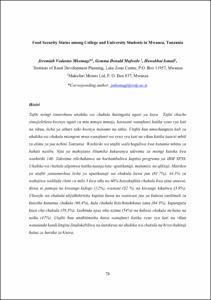| dc.description.abstract | Most studies concerning food security focus on the household level. Less attention has been paid to the individual level specifically, students in colleges and universities, despite its potential impacts on students' academics and behaviour. This cross-sectional study investigated food security status among college and university students based on two higher learning institutions in Tanzania.A simple random sampling technique was used to select the study participants whereas 140 respondents were interviewed using an interview schedule. The IBM Statistical Package for Social Science software was used to process and analyse the collected data. Three proxies: availability, utilisation, and access were used to measure food security. The results show food availability was high (81.7%), 44.3% of respondents ate less than three meals per day (utilisation) while 68% experienced various forms of food insecurity (access) ranging from mild (32%), moderate (32%) to severe (3.9%). Food insecurity manifested through worrying about not having an adequate resource to buy food (66.4%), eating less desired food (64.3%), reducing meal sizes (59.3%), not eating anything over a whole day time (54%) and going hungry day and night (47%). The study concludes food insecurity existed in the study area; making students food security risk groups requiring immediate policy interventions. | en_US |

